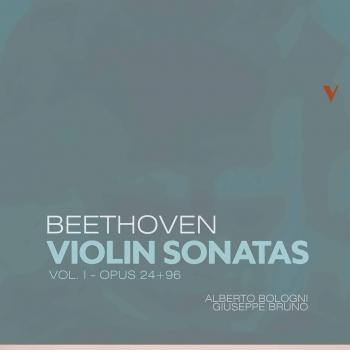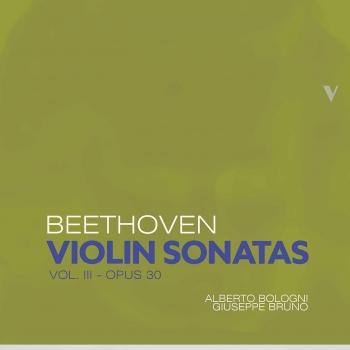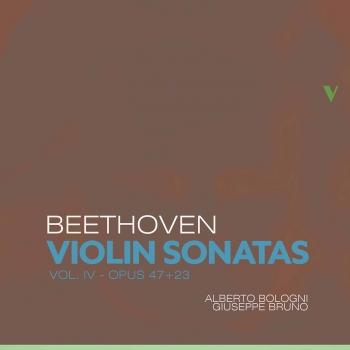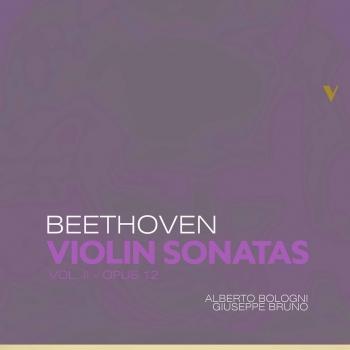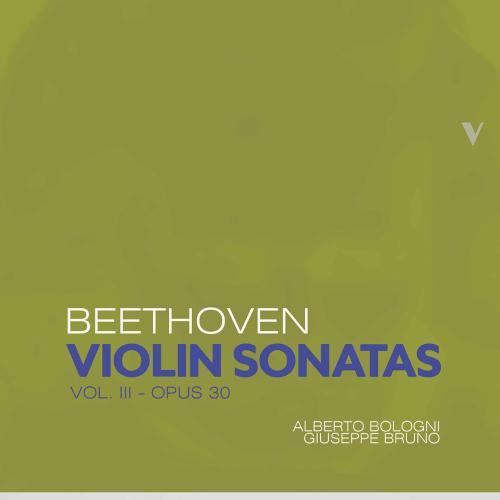
Beethoven: Violin Sonatas, Vol. 3 – Op. 30 Alberto Bologni & Giuseppe Bruno
Album info
Album-Release:
2020
HRA-Release:
01.05.2020
Label: OnClassical
Genre: Classical
Subgenre: Chamber Music
Artist: Alberto Bologni & Giuseppe Bruno
Composer: Ludwig van Beethoven (1770–1827)
Album including Album cover
- Ludwig van Beethoven (1770 - 1827): Violin Sonata No. 6 in A Major, Op. 30 No. 1:
- 1 Violin Sonata No. 6 in A Major, Op. 30 No. 1: I. Allegro 07:54
- 2 Violin Sonata No. 6 in A Major, Op. 30 No. 1: II. Adagio, molto espressivo 07:22
- 3 Violin Sonata No. 6 in A Major, Op. 30 No. 1: IIIa. Allegretto con variazioni 00:46
- 4 Violin Sonata No. 6 in A Major, Op. 30 No. 1: IIIb. Allegretto con variazioni. Var. 1 00:50
- 5 Violin Sonata No. 6 in A Major, Op. 30 No. 1: IIIc. Allegretto con variazioni. Var. 2 00:52
- 6 Violin Sonata No. 6 in A Major, Op. 30 No. 1: IIId. Allegretto con variazioni. Var. 3 00:53
- 7 Violin Sonata No. 6 in A Major, Op. 30 No. 1: IIIe. Allegretto con variazioni. Var. 4 00:56
- 8 Violin Sonata No. 6 in A Major, Op. 30 No. 1: IIIf. Allegretto con variazioni. Var. 5 01:48
- 9 Violin Sonata No. 6 in A Major, Op. 30 No. 1: IIIg. Allegretto con variazioni. Var. 6 02:21
- Violin Sonata No. 7 in C Minor, Op. 30 No. 2:
- 10 Violin Sonata No. 7 in C Minor, Op. 30 No. 2: I. Allegro con brio 08:09
- 11 Violin Sonata No. 7 in C Minor, Op. 30 No. 2: II. Adagio cantabile 10:12
- 12 Violin Sonata No. 7 in C Minor, Op. 30 No. 2: III. Scherzo. Allegro 03:50
- 13 Violin Sonata No. 7 in C Minor, Op. 30 No. 2: IV. Finale. Allegro 05:38
- Violin Sonata No. 8 in G Major, Op. 30 No. 3:
- 14 Violin Sonata No. 8 in G Major, Op. 30 No. 3: I. Allegro assai 07:02
- 15 Violin Sonata No. 8 in G Major, Op. 30 No. 3: II. Tempo di minuetto, ma molto moderato e grazioso 08:33
- 16 Violin Sonata No. 8 in G Major, Op. 30 No. 3: III. Allegro vivace 03:49
Info for Beethoven: Violin Sonatas, Vol. 3 – Op. 30
Beethoven opened the new century with the publication of his first symphony, but also with that of other important works, such as four piano sonatas (Opp. 26, 27, and 28) and two sonatas for piano and violin – in A Minor, Op. 23, and F Major, Op. 24. Originally, the two sonatas were published in 1801 as a set, under the opus number 23. But something as trivial as their having been mistakenly printed on different-size paper in their second reprint a year later compelled the publisher (and Beethoven) to present them as two distinct works, each with its own opus number – probably to save both face and money. Unlike its companion in F major, the Sonata Op. 23 is a rather stark work, remaining in the darkness of minor keys, and often in a contained, two-voice writing in the piano part. Success was granted to Op. 23, however, after a rather negative response to Beethoven’s three earlier works in the genre, published in 1798 as Op. 12. This achievement encouraged the composer to continue in the genre, with the publication of the Three Sonatas, Op. 30 a year later. Probably written during his sojourn in Heiligenstadt, Beethoven published the works in 1803 and dedicated them to the Tsar Alexander I of Russia. Op. 30 departs from the more traditional writing found in Opp. 12, 23, and 24: both violin and piano parts reach new levels of complexity, with expanded structures, florid virtuosity, and more sophisticated interactions between the two instruments. The final movement of the first of the three sonatas was considered too challenging and was substituted by a simpler set of variations.
During the time the Sonatas Op. 30 were being published, Beethoven began to work on a new sonata for piano and violin. Of ambitious proportions, both in length and difficulty, the sonata is considered the pinnacle of Beethoven’s contribution to the genre. It was published in 1805 as Op. 47. The last movement was a reworked version of the abovementioned discarded rondo from the Sonata in A Major, Op. 30, No. 1; and the opening measures of the first movement, in the key of A major, spiritually seem to connect the final measures of the Sonata, Op. 30, No. 1 to the Presto of the first movement in Op. 47. A peculiar story involves the premiere of the work, given by Beethoven himself and the English violinist George Bridgewater at Vienna’s Augarten Theater, at the early (and uncommon) hour of 8:00 AM on May 24, 1803. According to legend, Bridgewater arrived shortly before the performance was scheduled and performed the work at sight. At a gathering following the performance, the violinist allegedly insulted a woman whom Beethoven admired. The composer left in a rage and crossed off the dedication of the sonata to Bridgewater. Later, he dedicated the work to Rodolphe Kreutzer, who was considered one of the finest violinists of the early 19th century. Kreutzer, however, never played the sonata, and reportedly disliked it.
The duo formed by violinist Alberto Bologni and pianist Giuseppe Bruno is one of the most long-standing ensembles on the Italian scene. During thirty-five years of activity together, in which they have performed hundreds of concerts, we are happy to announce two important recordings made for our label, OnClassical: and, yes, the first is dedicated to Ludwig van Beethoven.
This four-volume cycle, containing all Beethoven's ten Violin Sonatas, the duo gives an analytical and refined reading, highlighting the compositional complexity of each work.
The recordings were made by sound engineer Alessandro Simonetto using a historical pair of Bruel & Kjaer microphones matched with Prism Sound pres and converters equipment. The outcome is a clean and natural sound.
Giuseppe Bruno, piano
Alberto Bologni, violin
Alberto Bologni
(b. Prato, 9th december 1963), studied under the guidance of Sandro Materassi and graduated with full honour at Conservatorio Luigi Cherubini di Firenze. Later he studied with Stefan Gheorghiu and Ilja Grubert, taking the soloist degree at Rotterdams Conservatorium. He also studied quartet with Piero Farulli at Accademia Chigiana di Siena. He was prize winner at Viotti and Spohr Competitions.
Mr. Bologni began his career in 1979, after being awarded the Leonardo da Vinci prize in Florence. He played in duo with the pianist Giuseppe Bruno or as leader of Sandro Materassi string quartet and piano quintet in the most important concert halls and theatres in Italy, Germany, Switzerland, England and Venezuela (Carlo Felice di Genova, Pergola di Firenze, St. John Smith Square Hall in London, Gasteig and Herkulessaal in München, Manzoni di Milano, Caio Melisso di Spoleto Università di Roma, Bellini di Catania etc. etc.). As a soloist he played with such conductors as Bellugi, Bruggen, Dumbraveanu, Harrap, Maschat, Mihaescu, Pinzauti etc. He has been the leading concertmaster since its foundation of Camerata Strumentale Città di Prato, considered one of the best Italian chamber orchestras now operating.
Alberto Bologni recorded CD's for the labels such as Diapason, Arts, Tactus, Cristophorus and through the Materassi ensemble with Radio Svizzera Italiana and Radio Suisse Romande.
Giuseppe Bruno
graduated with honours in Piano, Composition and Conductorship with Professors Specchi, Zangelmi and Taverna. Maestro Bruno specialized in piano with Paolo Bordoni and in conductorship with Leopold Hager. He has attended a seminar in composition at the IRCAM in Paris. Performing for several years as a pianist in many different chamber ensembles as well as a brilliant soloist. He has played with many important orchestras in Italy, USA, Greece, Romania and Germany in a repertory that goes from Mozart to Dallapiccola. From 1987 to 1992 he participated in the “Due Mondi” festival in Spoleto Italy and in 1988 in the Charleston festival in the USA.
In 1991 Maestro Bruno received an award at the International Piano Contest in Rome and in 1992 he received a second award in a duo with violin player Alberto Bologni at the “Viotti” in Vercelli, Italy. He recorded for Nuova Fonit Cetra, Diapason, SAM, Bongiovanni, Ars publica, Ars Musici, as well as for RAI, Swiss French and Italian radio and for WDR in Koeln. He collaborated with directors including Alkis Baltas, Spiros Argiris, Franz Lamprecht, Corneliu Dumbraveanu, violin player Sashko Gawriloff, singers Gail Gilmore and Victor von Halem, and with the Octet of Berlin Philharmonic. He is currently a member of the “Trio Petrarca”. In the past few years he has been acknowledged as a highly regarded conductor in Italy and abroad. Maestro Bruno is at present the Director of the "Giacomo Puccini" Conservatory, in La Spezia, Italy.
This album contains no booklet.











